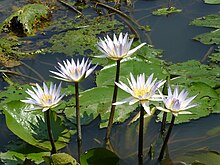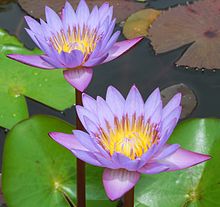Nymphaea nouchali
| Nymphaea nouchali | |
|---|---|

| |
| Scientific classification | |
| Kingdom: | Plantae |
| Clade: | Tracheophytes |
| Clade: | Angiosperms |
| Order: | Nymphaeales |
| Family: | Nymphaeaceae |
| Genus: | Nymphaea |
| Species: | N. nouchali
|
| Binomial name | |
| Nymphaea nouchali Burm. f.
| |
| Synonyms[1] | |
| |
Nymphaea nouchali, often known by its synonym Nymphaea stellata, or by common names blue lotus,[1] star lotus,[citation needed] red water lily, blue water lily, blue star water lily or manel flower, is a water lily of genus Nymphaea. It is native to southern and eastern parts of Asia, and is the national flower of Bangladesh and Sri Lanka. In Sanskrit it is utpala. This species is usually considered to include the blue Egyptian lotus N. nouchali var. caerulea.[2] In the past, taxonomic confusion has occurred, with the name Nymphaea nouchali incorrectly applied to Nymphaea pubescens.[3]
Distribution and habitat[]


This aquatic plant is native in a broad region from Afghanistan, the Indian subcontinent, to Taiwan, southeast Asia, and Australia.[1] It has been long valued as a garden flower in Thailand and Myanmar to decorate ponds and gardens. In its natural state, N. nouchali is found in static or slow-flowing aquatic habitats of low to moderate depth.[citation needed]
Description[]

N. nouchali is a day-blooming nonviviparous plant with submerged roots and stems. Part of the leaves are submerged, while others rise slightly above the surface. The leaves are round and green on top; they usually have a darker underside. The floating leaves have undulating edges that give them a crenellated appearance. Their size is about 20–23 cm and their spread is 0.9 to 1.8 m.[citation needed]
This water lily has a beautiful flower which is usually violet blue in color with reddish edges. Some varieties have white, purple, mauve, or fuchsia-colored flowers, hence its name red and blue water lily. The flower has four or five sepals and 13-15 petals that have an angular appearance, making the flower look star-shaped from above. The cup-like calyx has a diameter of 11–14 cm.[citation needed]
Symbolism[]
N. nouchali is the national flower of Bangladesh.[4] A pale blue-flowered N. nouchali is the national flower of Sri Lanka, where it is known as nil mānel or nil mahanel (නිල් මානෙල්).[5]
In Sri Lanka, this plant usually grows in buffalo ponds and natural wetlands. Its beautiful aquatic flower has been mentioned in Sanskrit, Pali, and Sinhala literary works since ancient times under the names kuvalaya, indhīwara, niluppala, nilothpala, and nilupul as a symbol of virtue, discipline, and purity. Buddhist lore in Sri Lanka claims that this flower was one of the 108 auspicious signs found on Prince Siddhartha's footprint.[6] It is said that when Buddha died, lotus flowers blossomed everywhere he had walked in his lifetime.[citation needed]
Claire Waight Keller included the plant to represent Bangladesh and Sri Lanka in Meghan Markle's wedding veil, which included the distinctive flora of each Commonwealth country.[7]
N. nouchali might have been one of the plants eaten by the Lotophagi of Homer's Odyssey.[citation needed]
Uses[]
N. nouchali is used as an ornamental plant because of its spectacular flowers, and is most commonly used for the traditional and cultural festivals in Sri Lanka. It is also popular as an aquarium plant under the name "dwarf lily" or "dwarf red lily".[citation needed] Sometimes, it is grown for its flowers, while other aquarists prefer to trim the lily pads, and just have the underwater foliage.[citation needed]
N. nouchali is considered a medicinal plant in Indian Ayurvedic medicine under the name ambal; it was mainly used to treat indigestion.[8][full citation needed]
Like all water lilies, its pear-shaped, brown cottony-covered, potato-sized rhizomes, leaves and most of the plant are poisonous, and contain an alkaloid called nupharin. Unlike European species, this can (and must) be neutralised in the rhizomes of this species by boiling. In India these have been eaten as a famine food or as a medicinal. In Vietnam it was eaten roasted. In Sri Lanka it was formerly eaten as a type of medicine and its price was too high to serve as a normal meal, but in the 1940s some villagers began to cultivate the water lilies in the paddy fields left uncultivated during the monsoon season (Yala season), and the price dropped. It is eaten boiled and in curries. The tubers of this species are completely edible, during the dry season they consist almost entirely of starch, and were eaten in West Africa, usually boiled or roasted.[9]
The dried plant is collected from ponds, tanks, and marshes during the dry season and used in India as animal forage.[10]
Heraldry[]

The emblem of surgeon and obstetrician to Napoleon, Baron Antoine Dubois, (1756–1837).

Personal coat of arms of Cyril Newall, 1st Baron Newall (1946)

National Emblem of Bangladesh (1972–present)
See also[]
- Nymphaea caerulea, the Egyptian blue lotus or sacred blue lily
- Nymphaea lotus, the white lotus or Egyptian white water lily
- Nelumbo nucifera, the Indian lotus, sacred lotus
- List of freshwater aquarium plant species
References[]
- ^ Jump up to: a b c "Nymphaea nouchali". Germplasm Resources Information Network (GRIN). Agricultural Research Service (ARS), United States Department of Agriculture (USDA). Retrieved 20 April 2015.
- ^ The Plant List: A Working List of All Plant Species, retrieved 20 April 2015
- ^ Dezhi Fu; John H. Wiersema & Donald Padgett, Flora of China online, 6, retrieved 20 April 2015
- ^ Constitution Of The People's Republic Of Bangladesh Archived 2013-09-22 at the Wayback Machine
- ^ Hettiarachchi, Kumudini (November 7, 2010). "The Great Pretender". The Sunday Times, Sri Lanka. Retrieved 24 June 2013.
- ^ "National Stats of Bangladesh". park.org.
- ^ Jenny.minard (19 May 2018). "The Wedding Dress, Bridesmaids' Dresses and Page Boys' Uniforms". The Royal Family.
- ^ P. V. Sharma, Puṣpāyurvedaḥ - Pradhāna vitaraka Caukhambhā Bhāratī Akādamī, 1998
- ^ FR Irvine, RS Trickett - Water lilies as Food - Kew Bulletin, 1953
- ^ A Banerjee, S Matai - Composition of Indian aquatic plants in relation to utilization as animal forage - Journal of Aquatic plant management, 1990
External links[]
![]() Media related to Nymphaea nouchali at Wikimedia Commons
Media related to Nymphaea nouchali at Wikimedia Commons
- Neel kamal (blue waterlily) in Indian culture on Biodiversity of India portal.
- "Nymphaea stellata". Germplasm Resources Information Network (GRIN). Agricultural Research Service (ARS), United States Department of Agriculture (USDA). Taxon: Nymphaea stellata Willd. - Synonym of Nymphaea nouchali Burm. f.
- Perry D. Slocum: Waterlilies and Lotuses. Timber Press 2005, ISBN 0-88192-684-1 (restricted online version at Google Books)
- Ambal (Nymphaea stellata) - Flowers of India - Kerala Ayurvedics
- Freshwater plants
- Nymphaea
- Plants described in 1768
- National symbols of Sri Lanka
- Flora of Sri Lanka
- National symbols of Bangladesh
- Taxa named by Nicolaas Laurens Burman


